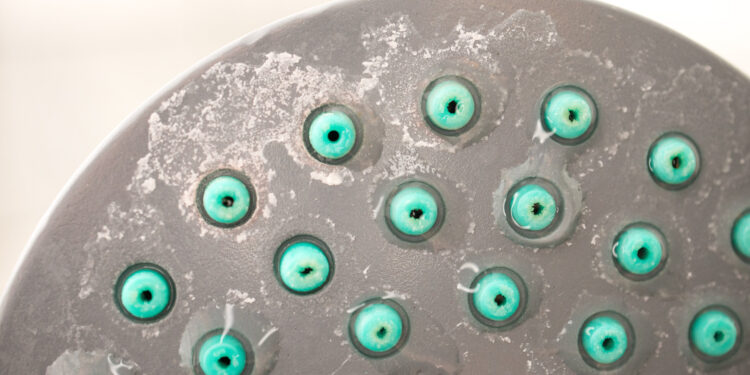In a new study, samples taken from shower heads and toothbrushes included more than 600 different viruses – and no two samples were the same. Credit: Ivan Radic
Forget tropical rainforests and coral reefs: the latest hotspot with impressive biodiversity is no further than your bathroom.
In a new study led by Northwestern University, microbiologists have discovered that showerheads and toothbrushes are teeming with an extremely diverse set of viruses, most of which have never been observed before.
Although this may seem worrying, the good news is that these viruses do not target humans. They target bacteria.
The microorganisms collected in the study are bacteriophages, or “phages,” a type of virus that infects and replicates inside bacteria. Although researchers know little about them, phages have recently gained attention because of their potential use in treating antibiotic-resistant bacterial infections. And the previously unknown viruses lurking in our bathrooms could become a treasure trove of materials for exploring these applications.
The study, “Phage communities in household biofilms correlate with bacterial hosts but do not associate with other environmental factors,” was published Wednesday, Oct. 9, in the journal Frontiers of microbiomes.
“The number of viruses we found is absolutely incredible,” said Erica M. Hartmann of Northwestern, who led the study. “We found many viruses that we know very little about and many more that we have never seen before. It’s amazing how much untapped biodiversity is all around us. And it’s not even You have to go very far to find it: it is right under our noses.”
An indoor microbiologist, Hartmann is an associate professor of civil and environmental engineering at Northwestern’s McCormick School of Engineering and a member of the Center for Synthetic Biology.
The return of “Operation Pottymouth”
The new study is an offshoot of earlier research, in which Hartmann and colleagues at the University of Colorado Boulder characterized bacteria living on toothbrushes and showerheads. For previous studies, researchers asked people to submit used toothbrushes and tampons along with samples taken from their shower heads.
Inspired by fears that flushing a toilet could generate a cloud of aerosol particles, Hartmann affectionately called the toothbrush study “Operation Pottymouth.”
“This project started as a curiosity,” Hartmann said. “We wanted to know what microbes live in our homes. If you think about indoor environments, surfaces like tables and walls are very difficult for microbes to live in. Microbes prefer environments with water. And where there are Is there water inside our shower heads and on our toothbrushes?
Diversity and opportunities
After characterizing the bacteria, Hartmann then used DNA sequencing to examine viruses living on those same samples. She was immediately blown away. In total, the samples included more than 600 different viruses, and no two samples were identical.
“We saw almost no overlap in virus types between shower heads and toothbrushes,” Hartmann said. “We also saw very little overlap between two samples. Each shower head and toothbrush is like its own little island. This only highlights the incredible diversity of viruses.”
Although they found few patterns among all the samples, Hartmann and his team noticed more mycobacteriophages than other types of phages. Mycobacteriophages infect mycobacteria, a pathogenic species responsible for diseases such as leprosy, tuberculosis and chronic lung infections. Hartmann imagines that one day, researchers could harness mycobacteriophages to treat these and other infections.
“We might look at taking these mycobacteriophages and using them as a way to eliminate pathogens from your plumbing system,” she said. “We want to look at all the functions these viruses might have and understand how we can use them.”
Most germs ‘won’t make us sick’
But in the meantime, Hartmann cautions people not to worry about the invisible wildlife that lives in our bathrooms. Instead of using bleach, people can soak their shower heads in vinegar to remove calcium buildup or simply wash them with plain soap and water. And people should replace toothbrush heads regularly, says Hartmann. Hartmann is also not a fan of antimicrobial toothbrushes, which she says can lead to antibiotic-resistant bugs.
“Germs are everywhere and the vast majority of them won’t make us sick,” she said. “The more you attack them with disinfectants, the more likely they are to develop resistance or become harder to treat. We should all embrace them.”
More information:
Phage communities in domestic biofilms correlate with bacterial hosts but do not associate with other environmental factors, Microbiome Frontiers (2024). www.frontiersin.org/journals/m … 024.1396560/abstract
Provided by Northwestern University
Quote: Microbial wonders: Study reveals “untapped biodiversity” in the bathroom, on your toothbrush and shower head (October 9, 2024) retrieved October 9, 2024 from
This document is subject to copyright. Except for fair use for private study or research purposes, no part may be reproduced without written permission. The content is provided for informational purposes only.



